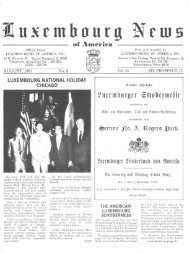$150.00 - Luxembourg American Heritage Information Center
$150.00 - Luxembourg American Heritage Information Center
$150.00 - Luxembourg American Heritage Information Center
Create successful ePaper yourself
Turn your PDF publications into a flip-book with our unique Google optimized e-Paper software.
As with most of the sections residing outside of the City of Chicago, the story of<br />
Section 15 is inextricably intertwined with that of the small town in which it was<br />
started. Many of the 313 men who comprised Section 15 would be the same ones who<br />
were elected or appointed to lead their fellow citizens in government, commerce and<br />
the affairs of every day life in Niles <strong>Center</strong>, Illinois.* The life of Section 15 is reflected in the lives of<br />
its brothers and this essay is intended as a celebration of the accomplishments of these men.<br />
The township of Niles was organized in 1850. By definition imposed by the Basic Land<br />
Ordinance of 1785, a township was six miles square. It was at the approximate geographical<br />
center of this township that the Village of Niles <strong>Center</strong> was begun by a few hearty souls. Although<br />
the first white settlers arrived in this area in 1834, the Village was not incorporated until 1888, less<br />
the one year after the organization of the <strong>Luxembourg</strong> Brotherhood in Chicago. Their paths<br />
would amble side by side for the next 100 years.<br />
The first permanent settlers, John Planch and the Ebinger brothers, reportedly came from<br />
Germany in the 1830's. Migration continued to build the population base of the area. The Harms<br />
family patriarch, Heinrich Henry Harms, came to this area from Germany in 1851. Two of his<br />
descendants (Edward H. and Percy) would become members. In 1864, George C. Klehm came<br />
to Niles Township and married Heinrich Harms' sister Eliza a/k/a Louise. One of his descendants,<br />
Harold, known as Holly, became a member in 1935 and was to operate a successful dry<br />
cleaning business for many years. In the late 1930's, he became a director of the Niles <strong>Center</strong> State<br />
Bank (now known as First National Bank of Skokie), one of eight members to hold that position<br />
in the 80 year history of the bank. In 1869, Ivan Paroubek, Sr. came to Niles Township from his<br />
native Bohemia. He was a harness maker who opened his business at 8041 Lincoln Avenue. Two<br />
of his sons, Anthony and Ivan M. would become members in 1909 and 1919. In 1852, Peter<br />
Blameuser, Jr. emigrated from the Alsace-Lorraine region on the Franco-Prussian border. Before<br />
settling in Niles Township in 1865, he sojourned westward where he became involved with a<br />
vigilante group which ultimately hanged 33 men convicted of a variety of crimes. His son, Peter<br />
Blameuser, III was born in Niles Township in 1866 and would become Niles <strong>Center</strong>'s third<br />
Village President in 1895. His grandson, George E., originally a member of Section 8, transferred<br />
to Section 15 in 1961, and his great grandson, George P., would also join Section 15 in 1961.<br />
The question arises why did these pioneers come to this area. Two reasons which are readily<br />
apparent were inexpensive land upon which to establish their homes and farms and proximity to<br />
markets in Chicago. The Harms, Klehms, Paroubeks and Blameusers became merchants, bakers<br />
and inn keepers to serve the growing population of farmers and flower growers who would<br />
predominate this area for the next sixty years. It was from these two latter groups that Section<br />
15 would draw its strength.<br />
In early 1888, an election was held to determine whether the inhabitants wished to<br />
incorporate. By a tally of 41 in favor of incorporation to 16 opposed, the citizens voted to officially<br />
incorporate the Village of Niles <strong>Center</strong>. An organizational meeting was held at the firehouse on<br />
April 23, 1888 and the first ordinance, which regulated the use of streets, was passed on April 30,<br />
1888. The first President was Adam Harrer. Peter Blameuser, Jr. and Ivan Paroubek, Sr. were<br />
among four trustees.<br />
During this period, the Village became the focal point for area farmers. On the first Tuesday<br />
and third Thursday of each month they would congregate at Lincoln and Oakton Streets, spread<br />
north along both sides of Lincoln Avenue to St. Peter's Catholic Church and around the<br />
cemetery to Market Street (presently Searle Parkway) selling their vegetables and flowers.<br />
Merchants from Chicago, McHenry and Kane counties would peddle their wares to these same<br />
people. This activity lasted until approximately 1920.<br />
* In 1940, the Village of Niles <strong>Center</strong> adopted, by ordinance, the name Skokie. In this text, Niles <strong>Center</strong> shall be used<br />
for the period prior to 1941 and Skokie shall be used for the period subsequent to 1940.<br />
119





